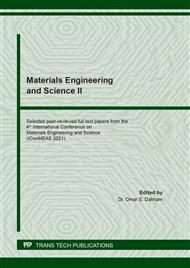p.3
p.9
p.17
p.27
p.33
p.40
p.49
p.55
Comparative Study of Polymeric Laminated Composites Reinforced by Different Fibers of Prosthetic Socket by DSC and FTIR
Abstract:
Prosthetic socket is the device that link artificial limb with the amputee part. This work has been done on seven laminated composite were prepared by vacuum technique from Polyester resin reinforced with (Jute, Carbon, Glass, Perlon) fibers. The interaction between fibers and matrix material was studied using Fourier transform infrared (FTIR) spectroscopy. DSC test also had been studied for different laminated composite materials to make prosthetic socket. The infrared spectra result of the Polyester composite specimens with natural and synthetic fibers indicate that no additional new peak was observed. While DSC results showed the increase in the glass transition temperature (Tg) as the number of Jute layers increased and this may be related to the nature of Jute fibers. As well as Carbon lead to increase Tg but Glass fiber decreased Tg when added to natural fiber (Jute fiber). The composite specimen reinforced with three layers of Jute fibers plus four layers of Carbon fibers (3 Jute + 4 Carbon) had the highest Tg (107°C).
Info:
Periodical:
Pages:
3-8
Citation:
Online since:
February 2022
Authors:
Keywords:
Price:
Сopyright:
© 2022 Trans Tech Publications Ltd. All Rights Reserved
Share:
Citation:


